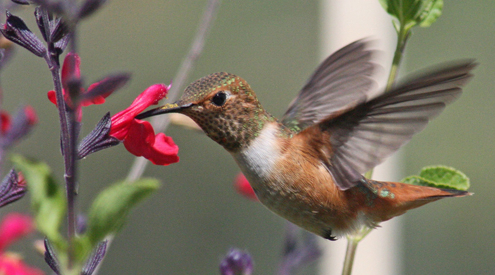
Hummingbirds and many other species benefit directly from the efforts of people who are conscientiously gardening to benefit birds and other wildlife (NWF photo by John Hobbs).
|
A new survey conducted for the National Wildlife Federation showed that more than 64 million Americans – comprising one in four adults – purchased plants because they were beneficial to birds, bees, and butterflies during the past three years. This spring, the National Wildlife Federation’s “Garden for Wildlife” program has seen its highest demand in its 47-year history, with six times more website visitors and double the number of annual Certified Wildlife Habitat registrations in the first quarter!
Preliminary research from the 2020 National Gardening Survey, conducted by the National Garden Association and the University of New Hampshire Survey Center on behalf of the National Wildlife Federation, showed that people are drawn to the beautiful results of gardening as science confirms they are making a difference to increase the abundance and diversity of wildlife species in their area through gardening.
Even during this pandemic period, the National Wildlife Federation’s 8th Annual Garden for Wildlife Month offers Americans a way to safely and responsibly connect with nature. From home gardeners to wildlife enthusiasts and conservationists, the Garden for Wildlife program offers everyone an accessible way to help local wildlife including migrating birds.
“The new National Gardening Survey shows people across America are purposefully planting for wildlife, making a conservation difference where they live, and advancing the wildlife gardening movement,” said Mary Phillips, senior director of the NWF’s Garden for Wildlife program.
“At the National Wildlife Federation, we hope even more people will find solace in wildlife gardening and will plant with purpose, creating eco-friendly green space to relax, rejuvenate, and get some much-needed outdoor time during these unprecedented times,” Phillips added; “While millions of people invite birds, butterflies, and bees to their yards by replacing lawn with native plants, smaller habitat oases can also be created in backyards, porches, patios, or even window sills.”
To reference the National Wildlife Federation’s press release and to access a wealth of information about Gardening for Wildlife, see https://www.nwf.org/Latest-News/Press-Releases/2020/05-05-20-2020-National-Gardening-Survey